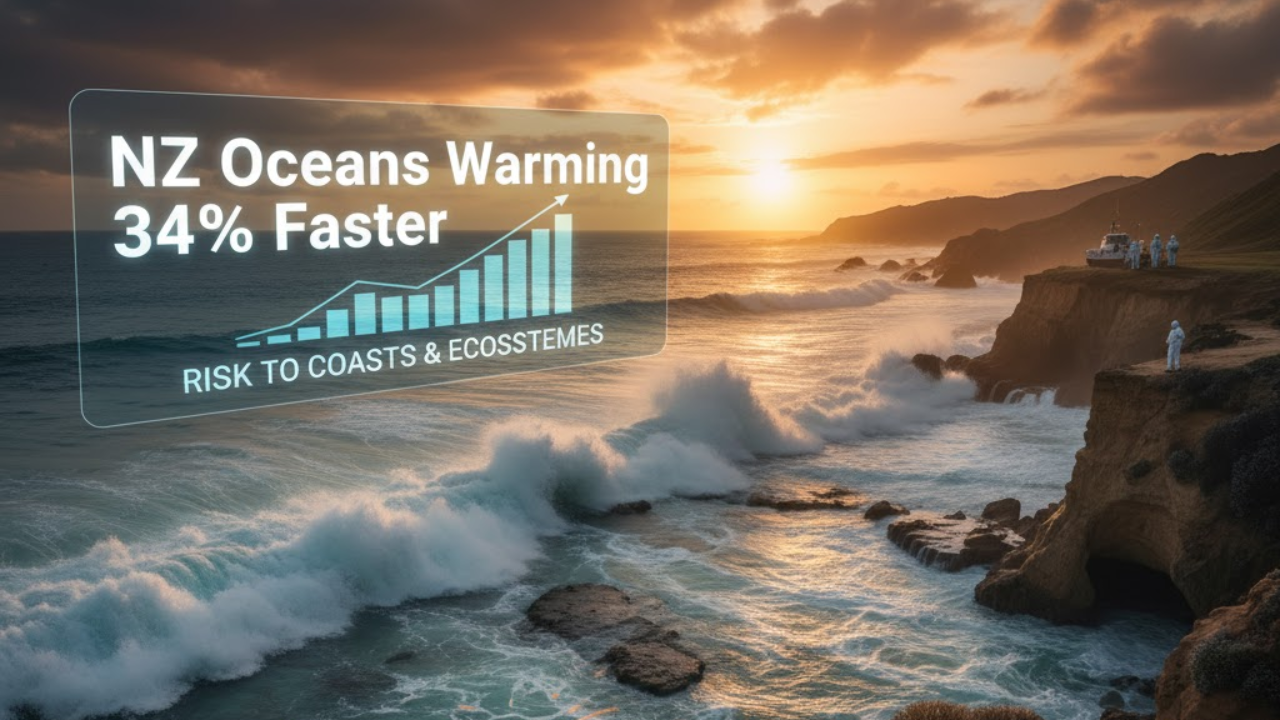
Post by : Naveen Mittal
In its latest environmental assessment, New Zealand has issued a stark warning: the seas encircling the country are warming 34 percent faster than the global average. This accelerated change isn’t simply a statistic—it’s a looming threat to biodiversity, coastal communities, fishing industries, and the very futures of island nations.
The new “Our Marine Environment 2025” report combines decades of oceanographic data to paint a worrying picture. Between 1982 and 2023, the sea-surface temperature around New Zealand rose at about 0.16 to 0.26 °C per decade, outpacing many regions globally. Meanwhile, marine heatwaves are becoming more frequent, longer-lasting, and more intense.
This trend is already forcing ecosystems and economies into crisis. Warming seas and acidification are disrupting habitat ranges, altering food chains, and pushing marine life toward the poles or into deeper waters.
The warming oceans are not just a problem for plants and fish—they’re shaking the foundations of human settlements. The report estimates that around 219,000 homes, worth billions, are vulnerable to coastal flooding due to rising sea levels. Infrastructure—roads, ports, utilities—is similarly exposed.
Projections suggest that by 2050, some regions might see 20–30 cm of additional sea-level rise, transforming a centennial coastal storm into an annual disaster. What used to be rare floods could become everyday occurrences in towns that now sit just above the high-tide line.
In places like Wellington and Auckland, subsidence (land sinking) compounds the danger, narrowing the margin between safe ground and inundation. Urban planners face the urgent challenge of relocating or fortifying vulnerable neighborhoods.
Ecological consequences are already evident. Species that depend on cool coastal waters—kelp forests, sponges, corals—are retreating or dying off. Fish stocks are shifting their ranges, altering traditional fishing zones. Some species are straining to adapt fast enough.
Marine biodiversity is further threatened by acidification, which reduces carbonate minerals used by shellfish and corals to build skeletons. Oxygen levels in warmer water also drop, stressing organisms adapted to richer, cooler seas.
New Zealand’s $1.1 billion fishing and aquaculture sector is particularly at risk. Shellfish closures, algal blooms, and mortality events have already begun to strain the industry’s stability.
Several interlocking forces are at play:
Ocean currents shifting: The subtropical front—a boundary between warm and cold ocean waters—has moved west by around 120 km, indicating a reorganization of heat distribution.
Atmospheric circulation changes: Wind patterns, jet streams, and warming air masses all affect how heat is transferred to the ocean.
Local geography and currents: New Zealand’s position between the Pacific, Tasman Sea, and Southern Ocean makes it especially vulnerable to warming influences from multiple directions.
Greenhouse gas accumulation: The primary engine behind all of this is still global warming, driven by increasing atmospheric emissions.
Together, these forces are magnifying warming in a way that outstrips global averages and regional norms.
The report calls for urgent, systemic responses. Some of the paths forward include:
Strengthen coastal defenses, including soft infrastructure like wetlands and dunes, rather than just seawalls.
Strategic retreat in zones that cannot be defended sustainably.
Better spatial planning, including restricting development in high-risk zones.
Marine protected areas to shield vulnerable species and increase ecological resilience.
Enhanced research and monitoring, especially filling gaps in oceanographic data, ecological responses, and climate modeling.
Community engagement and displacement planning, ensuring that affected populations have pathways to adapt or relocate.
Policymakers emphasize that delay is no longer an option—the changes are already underway, and every year of inaction increases the cost and damage to come.
New Zealand’s accelerated ocean warming is a microcosm for what many coastal and island nations face around the world. But its geographical insights, data transparency, and political will offer a reference model for adaptation and response.
The future of marine life, coastal cities, and economies depends on how fast humanity can respond—not just through emissions cuts, but through resilient design, early action, and ecosystem-based adaptation.
New Zealand may be the canary in the climate coal mine, but its lessons and strategies resonate far beyond its shores.
Disclaimer:
This article is for informational and educational purposes only. The data reflects the “Our Marine Environment 2025” report and other recent marine research. Readers should consult scientific agencies and governmental sources for the most current insights in marine science and climate adaptation.
ocean warming, New Zealand, marine heatwaves, climate change, coastal risk, marine ecosystems, sea-level rise, ocean acidification










Lazio Denies Qatari Sale Rumors, Files Legal Complaints
Lazio refutes online claims of Qatari takeover talks, files reports with Italian regulators and judi

Penn State Fires Coach Franklin After Third Straight Loss
Penn State parts ways with James Franklin after 3 conference defeats, naming Terry Smith as interim

Denmark Beats Greece 3-1 to Stay Top in Qualifiers
Denmark wins 3-1 at home over Greece, keeps unbeaten record, and stays ahead of Scotland in Group C

Panthers Edge Cowboys 30-27 with Dowdle’s Big Game
Rico Dowdle dominates former team with 239 total yards as Panthers win 30-27 over Cowboys by last-se

Mariners Beat Blue Jays 3-1 to Win ALCS Game 1
Seattle shuts down Toronto’s bats and wins Game 1 of the ALCS 3-1, with strong pitching and timely h

Dutch Government Seizes Control of China-Owned Chipmaker Nexperia
The Netherlands government steps in over governance risks at Nexperia, suspends its Chinese parent’s